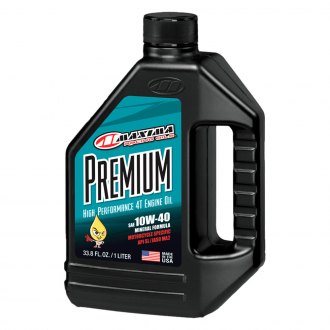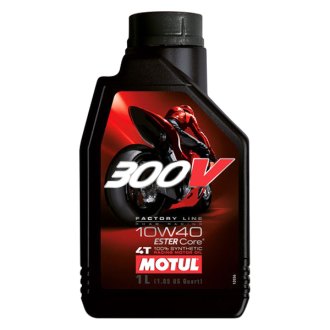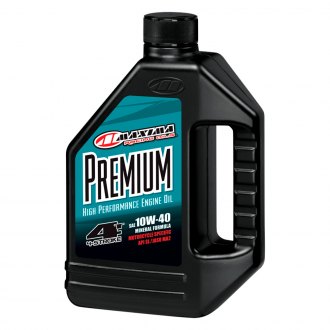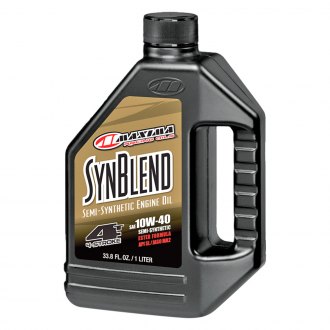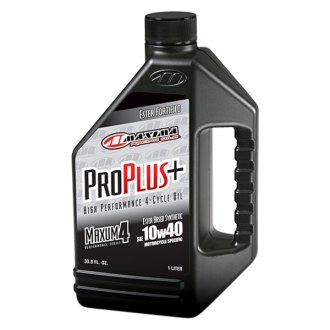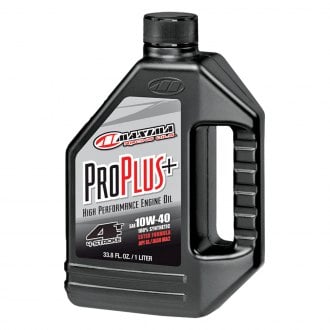Motorcycle Engine Oils & Additives

-
 Motul USA®300V SAE 10W-40 Synthetic FL Road Racing Motor Oil, 4 Liters (104121)300V SAE 10W-40 Synthetic FL Road Racing Motor Oil, 4 Liters (104121) by Motul USA®. This product is made of high-quality components to meet and exceed strict quality requirements. Designed using state-of-the-art technology and with...Crafted to deliver unbeatable levels of qualityHigh grade materials for exceptional performance$218.61
Motul USA®300V SAE 10W-40 Synthetic FL Road Racing Motor Oil, 4 Liters (104121)300V SAE 10W-40 Synthetic FL Road Racing Motor Oil, 4 Liters (104121) by Motul USA®. This product is made of high-quality components to meet and exceed strict quality requirements. Designed using state-of-the-art technology and with...Crafted to deliver unbeatable levels of qualityHigh grade materials for exceptional performance$218.61 -
 Maxima Racing Oils®Maxum 4 SAE 10W-40 Premium Motorcycle Engine Oil, 1 Liter (34901)Maxum 4 SAE 10W-40 Premium Motorcycle Engine Oil, 1 Liter (34901) by Maxima Racing Oils®. Maxima's Premium4 is a superior product featuring advanced additive technology in the development of highly stable and long life multi-grade...Viscosity StableHigh temperature additive system$8.34
Maxima Racing Oils®Maxum 4 SAE 10W-40 Premium Motorcycle Engine Oil, 1 Liter (34901)Maxum 4 SAE 10W-40 Premium Motorcycle Engine Oil, 1 Liter (34901) by Maxima Racing Oils®. Maxima's Premium4 is a superior product featuring advanced additive technology in the development of highly stable and long life multi-grade...Viscosity StableHigh temperature additive system$8.34 -
 Motul USA®300V SAE 10W-40 Synthetic FL Road Racing Motor Oil, 1 Liter (104118)300V SAE 10W-40 Synthetic FL Road Racing Motor Oil, 1 Liter (104118) by Motul USA®. This product is made of high-quality components to meet and exceed strict quality requirements. Designed using state-of-the-art technology and with...Crafted to deliver unbeatable levels of qualityHigh grade materials for exceptional performance$172.08
Motul USA®300V SAE 10W-40 Synthetic FL Road Racing Motor Oil, 1 Liter (104118)300V SAE 10W-40 Synthetic FL Road Racing Motor Oil, 1 Liter (104118) by Motul USA®. This product is made of high-quality components to meet and exceed strict quality requirements. Designed using state-of-the-art technology and with...Crafted to deliver unbeatable levels of qualityHigh grade materials for exceptional performance$172.08 -
 Lucas Oil®SAE 10W-40 Synthetic Motorcycle Oil, 1 Quart (10777)SAE 10W-40 Synthetic Motorcycle Oil, 1 Quart (10777) by Lucas Oil®. Lucas High Performance Semi-Synthetic 2-Cycle Oil has been specifically developed to give a long trouble-free life to gasoline-powered 2-cycle engines. Use in...Clean burning "Smokeless"Mixes well with gasolines at all temperatures$13.11
Lucas Oil®SAE 10W-40 Synthetic Motorcycle Oil, 1 Quart (10777)SAE 10W-40 Synthetic Motorcycle Oil, 1 Quart (10777) by Lucas Oil®. Lucas High Performance Semi-Synthetic 2-Cycle Oil has been specifically developed to give a long trouble-free life to gasoline-powered 2-cycle engines. Use in...Clean burning "Smokeless"Mixes well with gasolines at all temperatures$13.11 -
 Lucas Oil®High Performance SAE 10W-40 Semi-Synthetic Motor Oil, 1 Quart (LUC10710)High Performance SAE 10W-40 Semi-Synthetic Motor Oil, 1 Quart (LUC10710) by Lucas Oil®. Lucas SAE 10W-40 High Performance Motorcycle Oil is formulated with an exclusive additive package that is not found in other brands. It contains a...Made to provide the perfect lubricant solution for your needsDesigned with innovative manufacturing techniques$9.24
Lucas Oil®High Performance SAE 10W-40 Semi-Synthetic Motor Oil, 1 Quart (LUC10710)High Performance SAE 10W-40 Semi-Synthetic Motor Oil, 1 Quart (LUC10710) by Lucas Oil®. Lucas SAE 10W-40 High Performance Motorcycle Oil is formulated with an exclusive additive package that is not found in other brands. It contains a...Made to provide the perfect lubricant solution for your needsDesigned with innovative manufacturing techniques$9.24 -
 Lucas Oil®SXS High-Performance SAE 10W-40 Conventional Engine Oil, 55 Gallons (11199)SXS High-Performance SAE 10W-40 Conventional Engine Oil, 55 Gallons (11199) by Lucas Oil®. This top-grade product is expertly made in compliance with stringent industry standards to offer a fusion of a well-balanced design and high...Oil Type: Semi-SyntheticViscosity Grade: SAE 10W-40$1,949.84
Lucas Oil®SXS High-Performance SAE 10W-40 Conventional Engine Oil, 55 Gallons (11199)SXS High-Performance SAE 10W-40 Conventional Engine Oil, 55 Gallons (11199) by Lucas Oil®. This top-grade product is expertly made in compliance with stringent industry standards to offer a fusion of a well-balanced design and high...Oil Type: Semi-SyntheticViscosity Grade: SAE 10W-40$1,949.84 -
 Lucas Oil®SXS High-Performance SAE 10W-40 Semi-Synthetic 4-Stroke Engine Oil, 1 Gallon (11197)SXS High-Performance SAE 10W-40 Semi-Synthetic 4-Stroke Engine Oil, 1 Gallon (11197) by Lucas Oil®. This top-grade product is expertly made in compliance with stringent industry standards to offer a fusion of a well-balanced design and...Crafted to deliver unbeatable levels of qualityHigh grade materials for exceptional performance$39.31
Lucas Oil®SXS High-Performance SAE 10W-40 Semi-Synthetic 4-Stroke Engine Oil, 1 Gallon (11197)SXS High-Performance SAE 10W-40 Semi-Synthetic 4-Stroke Engine Oil, 1 Gallon (11197) by Lucas Oil®. This top-grade product is expertly made in compliance with stringent industry standards to offer a fusion of a well-balanced design and...Crafted to deliver unbeatable levels of qualityHigh grade materials for exceptional performance$39.31 -
 Lucas Oil®SXS High-Performance SAE 10W-40 Semi-Synthetic Engine Oil, 1 Quart (LUC11196)SXS High-Performance SAE 10W-40 Semi-Synthetic Engine Oil, 1 Quart (LUC11196) by Lucas Oil®. This top-grade product is expertly made in compliance with stringent industry standards to offer a fusion of a well-balanced design and high...Oil Type: Semi-SyntheticViscosity Grade: SAE 10W-40$10.35
Lucas Oil®SXS High-Performance SAE 10W-40 Semi-Synthetic Engine Oil, 1 Quart (LUC11196)SXS High-Performance SAE 10W-40 Semi-Synthetic Engine Oil, 1 Quart (LUC11196) by Lucas Oil®. This top-grade product is expertly made in compliance with stringent industry standards to offer a fusion of a well-balanced design and high...Oil Type: Semi-SyntheticViscosity Grade: SAE 10W-40$10.35 -
 Lucas Oil®SXS High-Performance SAE 10W-50 Synthetic 4-Stroke Engine Oil, 1 Gallon (11213)SXS High-Performance SAE 10W-50 Synthetic 4-Stroke Engine Oil, 1 Gallon (11213) by Lucas Oil®. This top-grade product is expertly made in compliance with stringent industry standards to offer a fusion of a well-balanced design and high...Crafted to deliver unbeatable levels of qualityHigh grade materials for exceptional performance$52.42
Lucas Oil®SXS High-Performance SAE 10W-50 Synthetic 4-Stroke Engine Oil, 1 Gallon (11213)SXS High-Performance SAE 10W-50 Synthetic 4-Stroke Engine Oil, 1 Gallon (11213) by Lucas Oil®. This top-grade product is expertly made in compliance with stringent industry standards to offer a fusion of a well-balanced design and high...Crafted to deliver unbeatable levels of qualityHigh grade materials for exceptional performance$52.42 -
 Lucas Oil®SXS High-Performance SAE 10W-50 Synthetic Engine Oil, 55 Gallons (11215)SXS High-Performance SAE 10W-50 Synthetic Engine Oil, 55 Gallons by Lucas Oil®. This top-grade product is expertly made in compliance with stringent industry standards to offer a fusion of a well-balanced design and high level of...Oil Type: Semi-SyntheticViscosity Grade: SAE 10W-40$2,218.78
Lucas Oil®SXS High-Performance SAE 10W-50 Synthetic Engine Oil, 55 Gallons (11215)SXS High-Performance SAE 10W-50 Synthetic Engine Oil, 55 Gallons by Lucas Oil®. This top-grade product is expertly made in compliance with stringent industry standards to offer a fusion of a well-balanced design and high level of...Oil Type: Semi-SyntheticViscosity Grade: SAE 10W-40$2,218.78 -
 Royal Purple®Max-Cycle™ SAE 10W-40 Synthetic High Performance Motorcycle Engine Oil, 1 Quart (21315)Max-Cycle™ SAE 10W-40 Synthetic High Performance Motorcycle Engine Oil, 1 Quart by Royal Purple®. Max-Cycle synthetic engine oil is available in 10W-40, and 20W-50, and is specifically formulated to exceed the demands of highly...Greater wear protectionCleaner, more efficient engines$13.61
Royal Purple®Max-Cycle™ SAE 10W-40 Synthetic High Performance Motorcycle Engine Oil, 1 Quart (21315)Max-Cycle™ SAE 10W-40 Synthetic High Performance Motorcycle Engine Oil, 1 Quart by Royal Purple®. Max-Cycle synthetic engine oil is available in 10W-40, and 20W-50, and is specifically formulated to exceed the demands of highly...Greater wear protectionCleaner, more efficient engines$13.61 -
 Maxima Racing Oils®Maxum 4 SAE 10W-40 Premium Motorcycle Engine Oil, 1 Gallon (349128)Maxum 4 SAE 10W-40 Premium Motorcycle Engine Oil, 1 Gallon (349128) by Maxima Racing Oils®. Maxima's Premium4 is a superior product featuring advanced additive technology in the development of highly stable and long life multi-grade...Viscosity StableHigh temperature additive system$28.56
Maxima Racing Oils®Maxum 4 SAE 10W-40 Premium Motorcycle Engine Oil, 1 Gallon (349128)Maxum 4 SAE 10W-40 Premium Motorcycle Engine Oil, 1 Gallon (349128) by Maxima Racing Oils®. Maxima's Premium4 is a superior product featuring advanced additive technology in the development of highly stable and long life multi-grade...Viscosity StableHigh temperature additive system$28.56 -
 Maxima Racing Oils®Maxum 4 SAE 10W-40 Semi-Synthetic Motorcycle Engine Oil, 1 Gallon (349128B)Maxum 4 SAE 10W-40 Semi-Synthetic Motorcycle Engine Oil, 1 Gallon (349128B) by Maxima Racing Oils®. Maxima's Synthetic Blend4 is a blend of ester-based synthetic and petroleum base stocks featuring advanced technology. This special high...Ester Based SyntheticReduces friction & engine temperatures$30.14
Maxima Racing Oils®Maxum 4 SAE 10W-40 Semi-Synthetic Motorcycle Engine Oil, 1 Gallon (349128B)Maxum 4 SAE 10W-40 Semi-Synthetic Motorcycle Engine Oil, 1 Gallon (349128B) by Maxima Racing Oils®. Maxima's Synthetic Blend4 is a blend of ester-based synthetic and petroleum base stocks featuring advanced technology. This special high...Ester Based SyntheticReduces friction & engine temperatures$30.14 -
 Maxima Racing Oils®Maxum 4 SAE 10W-40 Semi-Synthetic Motorcycle Engine Oil, 1 Liter (34901B)Maxum 4 SAE 10W-40 Semi-Synthetic Motorcycle Engine Oil, 1 Liter (34901B) by Maxima Racing Oils®. Maxima's Synthetic Blend4 is a blend of ester-based synthetic and petroleum base stocks featuring advanced technology. This special high...Ester Based SyntheticReduces friction & engine temperatures$9.18
Maxima Racing Oils®Maxum 4 SAE 10W-40 Semi-Synthetic Motorcycle Engine Oil, 1 Liter (34901B)Maxum 4 SAE 10W-40 Semi-Synthetic Motorcycle Engine Oil, 1 Liter (34901B) by Maxima Racing Oils®. Maxima's Synthetic Blend4 is a blend of ester-based synthetic and petroleum base stocks featuring advanced technology. This special high...Ester Based SyntheticReduces friction & engine temperatures$9.18 -
 Maxima Racing Oils®Maxum 4 SAE 10W-40 Synthetic Engine Oil, 1 Gallon (169128)Maxum 4 SAE 10W-40 Synthetic Engine Oil, 1 Gallon (169128) by Maxima Racing Oils®. Extra4 is a 100% synthetic motor oil featuring advanced additive technology. By using today's most advanced additive systems and high-performance...100% Triple Ester blendViscosity Stable$59.52
Maxima Racing Oils®Maxum 4 SAE 10W-40 Synthetic Engine Oil, 1 Gallon (169128)Maxum 4 SAE 10W-40 Synthetic Engine Oil, 1 Gallon (169128) by Maxima Racing Oils®. Extra4 is a 100% synthetic motor oil featuring advanced additive technology. By using today's most advanced additive systems and high-performance...100% Triple Ester blendViscosity Stable$59.52 -
 Maxima Racing Oils®Maxum Extra 4™ SAE 10W-40 Full Synthetic Engine Oil, 1 Liter (16901)Maxum Extra 4™ SAE 10W-40 Full Synthetic Engine Oil, 1 Liter (16901) by Maxima Racing Oils®. Full-synthetic, triple ester 4-stroke engine oil designed to ensure maximum performance while providing maximum protection under the most...Ultimate hardware protection & shifting confidence for even the most aggressive ridersInnovative formulation enables maximum power while ensuring optimal clutch engagement$16.25
Maxima Racing Oils®Maxum Extra 4™ SAE 10W-40 Full Synthetic Engine Oil, 1 Liter (16901)Maxum Extra 4™ SAE 10W-40 Full Synthetic Engine Oil, 1 Liter (16901) by Maxima Racing Oils®. Full-synthetic, triple ester 4-stroke engine oil designed to ensure maximum performance while providing maximum protection under the most...Ultimate hardware protection & shifting confidence for even the most aggressive ridersInnovative formulation enables maximum power while ensuring optimal clutch engagement$16.25 -
 Maxima Racing Oils®Maxum Pro+™ SAE 10W-50 Conventional Engine Oil, 5 Gallons (30-19505)Maxum Pro+™ SAE 10W-50 Conventional Engine Oil, 5 Gallons by Maxima Racing Oils®. This top-grade product is expertly made in compliance with stringent industry standards to offer a fusion of a well-balanced design and high level of...Made to deliver trouble-free operation for years aheadOptimal protection against wear$246.89
Maxima Racing Oils®Maxum Pro+™ SAE 10W-50 Conventional Engine Oil, 5 Gallons (30-19505)Maxum Pro+™ SAE 10W-50 Conventional Engine Oil, 5 Gallons by Maxima Racing Oils®. This top-grade product is expertly made in compliance with stringent industry standards to offer a fusion of a well-balanced design and high level of...Made to deliver trouble-free operation for years aheadOptimal protection against wear$246.89 -
 Maxima Racing Oils®PWC Marine SAE 10W-40 Conventional 4T Engine Oil, 1 Liter (14901)PWC Marine SAE 10W-40 Conventional 4T Engine Oil, 1 Liter (14901) by Maxima Racing Oils®.$8.34
Maxima Racing Oils®PWC Marine SAE 10W-40 Conventional 4T Engine Oil, 1 Liter (14901)PWC Marine SAE 10W-40 Conventional 4T Engine Oil, 1 Liter (14901) by Maxima Racing Oils®.$8.34 -
 Maxima Racing Oils®Peformance™ SAE 10W-40 Conventional Motor Oil, 1 Quart (39-34901S)Peformance™ SAE 10W-40 Conventional Motor Oil, 1 Quart by Maxima Racing Oils®. This product is made of high-quality components to meet and exceed strict quality requirements. Designed using state-of-the-art technology and with...$10.60
Maxima Racing Oils®Peformance™ SAE 10W-40 Conventional Motor Oil, 1 Quart (39-34901S)Peformance™ SAE 10W-40 Conventional Motor Oil, 1 Quart by Maxima Racing Oils®. This product is made of high-quality components to meet and exceed strict quality requirements. Designed using state-of-the-art technology and with...$10.60 -
 Maxima Racing Oils®Performance Brake-In Scooter 4T SAE 10W-40 Conventional Engine Oil, 1 Liter (11901)Performance Brake-In Scooter 4T SAE 10W-40 Conventional Engine Oil, 1 Liter by Maxima Racing Oils®. This top-grade product is expertly made in compliance with stringent industry standards to offer a fusion of a well-balanced design and...Crafted to deliver unbeatable levels of qualityHigh grade materials for exceptional performance$7.51
Maxima Racing Oils®Performance Brake-In Scooter 4T SAE 10W-40 Conventional Engine Oil, 1 Liter (11901)Performance Brake-In Scooter 4T SAE 10W-40 Conventional Engine Oil, 1 Liter by Maxima Racing Oils®. This top-grade product is expertly made in compliance with stringent industry standards to offer a fusion of a well-balanced design and...Crafted to deliver unbeatable levels of qualityHigh grade materials for exceptional performance$7.51 -
 Maxima Racing Oils®Pro Plus+ SAE 10W-40 Synthetic 4T Motorcycle Engine Oil, 1 Gallon (30-029128)Pro Plus+ SAE 10W-40 Synthetic 4T Motorcycle Engine Oil, 1 Gallon (30-029128) by Maxima Racing Oils®. Full-synthetic, ester-fortified 4-stroke engine oil designed to ensure optimum protection, peak performance and positive clutch feel....Superior protection at any temperatureExcellent clutch feel and clutch protection$43.65
Maxima Racing Oils®Pro Plus+ SAE 10W-40 Synthetic 4T Motorcycle Engine Oil, 1 Gallon (30-029128)Pro Plus+ SAE 10W-40 Synthetic 4T Motorcycle Engine Oil, 1 Gallon (30-029128) by Maxima Racing Oils®. Full-synthetic, ester-fortified 4-stroke engine oil designed to ensure optimum protection, peak performance and positive clutch feel....Superior protection at any temperatureExcellent clutch feel and clutch protection$43.65 -
 Maxima Racing Oils®Pro Plus+ SAE 10W-40 Synthetic 4T Motorcycle Engine Oil, 1 Liter x 12 Bottles (30-02901)Pro Plus+ SAE 10W-40 Synthetic 4T Motorcycle Engine Oil, 1 Liter x 12 Bottles (30-02901) by Maxima Racing Oils®. Full-synthetic, ester-fortified 4-stroke engine oil designed to ensure optimum protection, peak performance and positive...Superior protection at any temperatureExcellent clutch feel and clutch protection$175.80
Maxima Racing Oils®Pro Plus+ SAE 10W-40 Synthetic 4T Motorcycle Engine Oil, 1 Liter x 12 Bottles (30-02901)Pro Plus+ SAE 10W-40 Synthetic 4T Motorcycle Engine Oil, 1 Liter x 12 Bottles (30-02901) by Maxima Racing Oils®. Full-synthetic, ester-fortified 4-stroke engine oil designed to ensure optimum protection, peak performance and positive...Superior protection at any temperatureExcellent clutch feel and clutch protection$175.80 -
 Maxima Racing Oils®Pro Plus+ SAE 10W-40 Synthetic 4T Motorcycle Engine Oil, 5 Gallons (30-02505)Pro Plus+ SAE 10W-40 Synthetic 4T Motorcycle Engine Oil, 5 Gallons (30-02505) by Maxima Racing Oils®. Full-synthetic, ester-fortified 4-stroke engine oil designed to ensure optimum protection, peak performance and positive clutch feel....Superior protection at any temperatureExcellent clutch feel and clutch protection$234.54
Maxima Racing Oils®Pro Plus+ SAE 10W-40 Synthetic 4T Motorcycle Engine Oil, 5 Gallons (30-02505)Pro Plus+ SAE 10W-40 Synthetic 4T Motorcycle Engine Oil, 5 Gallons (30-02505) by Maxima Racing Oils®. Full-synthetic, ester-fortified 4-stroke engine oil designed to ensure optimum protection, peak performance and positive clutch feel....Superior protection at any temperatureExcellent clutch feel and clutch protection$234.54 -
 Maxima Racing Oils®Pro Plus+ SAE 10W-40 Synthetic Engine Oil, 1 Liter (30-02901S)Pro Plus+ SAE 10W-40 Synthetic Engine Oil, 1 Liter (30-02901S) by Maxima Racing Oils®. Full-synthetic, ester-fortified 4-stroke engine oil designed to ensure optimum protection, peak performance and positive clutch feel. Surface-active,...Superior protection at any temperatureExcellent clutch feel and clutch protection$14.64
Maxima Racing Oils®Pro Plus+ SAE 10W-40 Synthetic Engine Oil, 1 Liter (30-02901S)Pro Plus+ SAE 10W-40 Synthetic Engine Oil, 1 Liter (30-02901S) by Maxima Racing Oils®. Full-synthetic, ester-fortified 4-stroke engine oil designed to ensure optimum protection, peak performance and positive clutch feel. Surface-active,...Superior protection at any temperatureExcellent clutch feel and clutch protection$14.64 -
 Maxima Racing Oils®Pro Plus+ SAE 10W-50 Synthetic 4T Motorcycle Engine Oil, 1 Gallon (30-199128)Pro Plus+ SAE 10W-50 Synthetic 4T Motorcycle Engine Oil, 1 Gallon (30-199128) by Maxima Racing Oils®. Full-synthetic, ester-fortified 4-stroke engine oil designed to ensure optimum protection, peak performance and positive clutch feel....Superior protection at any temperatureExcellent clutch feel and clutch protection$46.01
Maxima Racing Oils®Pro Plus+ SAE 10W-50 Synthetic 4T Motorcycle Engine Oil, 1 Gallon (30-199128)Pro Plus+ SAE 10W-50 Synthetic 4T Motorcycle Engine Oil, 1 Gallon (30-199128) by Maxima Racing Oils®. Full-synthetic, ester-fortified 4-stroke engine oil designed to ensure optimum protection, peak performance and positive clutch feel....Superior protection at any temperatureExcellent clutch feel and clutch protection$46.01 -
 Maxima Racing Oils®Pro Plus+ SAE 10W-50 Synthetic 4T Motorcycle Engine Oil, 1 Liter x 12 Bottles (30-19901)Pro Plus+ SAE 10W-50 Synthetic 4T Motorcycle Engine Oil, 1 Liter x 12 Bottles (30-19901) by Maxima Racing Oils®. Full-synthetic, ester-fortified 4-stroke engine oil designed to ensure optimum protection, peak performance and positive...Superior protection at any temperatureExcellent clutch feel and clutch protection$185.31
Maxima Racing Oils®Pro Plus+ SAE 10W-50 Synthetic 4T Motorcycle Engine Oil, 1 Liter x 12 Bottles (30-19901)Pro Plus+ SAE 10W-50 Synthetic 4T Motorcycle Engine Oil, 1 Liter x 12 Bottles (30-19901) by Maxima Racing Oils®. Full-synthetic, ester-fortified 4-stroke engine oil designed to ensure optimum protection, peak performance and positive...Superior protection at any temperatureExcellent clutch feel and clutch protection$185.31 -
 Maxima Racing Oils®Pro Plus+ SAE 10W-50 Synthetic Engine Oil, 1 Liter (30-19901S)Pro Plus+ SAE 10W-50 Synthetic Engine Oil, 1 Liter by Maxima Racing Oils®. Full-synthetic, ester-fortified 4-stroke engine oil designed to ensure optimum protection, peak performance and positive clutch feel. Surface-active,...Superior protection at any temperatureExcellent clutch feel and clutch protection$15.67
Maxima Racing Oils®Pro Plus+ SAE 10W-50 Synthetic Engine Oil, 1 Liter (30-19901S)Pro Plus+ SAE 10W-50 Synthetic Engine Oil, 1 Liter by Maxima Racing Oils®. Full-synthetic, ester-fortified 4-stroke engine oil designed to ensure optimum protection, peak performance and positive clutch feel. Surface-active,...Superior protection at any temperatureExcellent clutch feel and clutch protection$15.67 -
 Maxima Racing Oils®SAE 10W-40 Mineral Technical Service Engine Oil, 55 Gallons (10055)SAE 10W-40 Mineral Technical Service Engine Oil, 55 Gallons (10055) by Maxima Racing Oils®. Mineral based 4-stroke engine oil designed to ensure optimum protection, peak performance and positive clutch feel. Provides excellent film...Superior protection at any temperatureExcellent clutch feel and protection$1,234.50
Maxima Racing Oils®SAE 10W-40 Mineral Technical Service Engine Oil, 55 Gallons (10055)SAE 10W-40 Mineral Technical Service Engine Oil, 55 Gallons (10055) by Maxima Racing Oils®. Mineral based 4-stroke engine oil designed to ensure optimum protection, peak performance and positive clutch feel. Provides excellent film...Superior protection at any temperatureExcellent clutch feel and protection$1,234.50 -
 Maxima Racing Oils®SXS SAE 10W-40 Conventional Premium Engine Oil, 1 Liter x 12 Bottles (30-04901)SXS SAE 10W-40 Conventional Premium Engine Oil, 1 Liter x 12 Bottles (30-04901) by Maxima Racing Oils®. Mineral based 4-stroke engine oil specifically formulated for side-by-side (SXS) engines. Shear-stable polymer system provides...Recommended for use in all OEM equipmentFormulated specifically for SXS engines$8.34
Maxima Racing Oils®SXS SAE 10W-40 Conventional Premium Engine Oil, 1 Liter x 12 Bottles (30-04901)SXS SAE 10W-40 Conventional Premium Engine Oil, 1 Liter x 12 Bottles (30-04901) by Maxima Racing Oils®. Mineral based 4-stroke engine oil specifically formulated for side-by-side (SXS) engines. Shear-stable polymer system provides...Recommended for use in all OEM equipmentFormulated specifically for SXS engines$8.34 -
 Maxima Racing Oils®SXS SAE 10W-40 Premium Engine Oil, 1 Gallon (30-049128)SXS SAE 10W-40 Premium Engine Oil, 1 Gallon (30-049128) by Maxima Racing Oils®. Mineral based 4-stroke engine oil specifically formulated for side-by-side (SXS) engines. Shear-stable polymer system provides excellent film thickness and...Recommended for use in all OEM equipmentFormulated specifically for SXS engines$28.56
Maxima Racing Oils®SXS SAE 10W-40 Premium Engine Oil, 1 Gallon (30-049128)SXS SAE 10W-40 Premium Engine Oil, 1 Gallon (30-049128) by Maxima Racing Oils®. Mineral based 4-stroke engine oil specifically formulated for side-by-side (SXS) engines. Shear-stable polymer system provides excellent film thickness and...Recommended for use in all OEM equipmentFormulated specifically for SXS engines$28.56
Oil is the key to the optimal performance and long service life of your motorcycle's engine. There's a lot more to it than just lubrication. Motorcycle engine oil also acts as a coolant and its formulation incorporates plenty of additives that inhibit corrosion and oxidation processes and minimize dirt and carbon buildup keeping the engine clean. Many of the modern bikes have a wet clutch which means the same oil is used for the engine, transmission, and clutch. Given its importance to your motorcycle's engine and gearbox health, oil must be checked and changed at regular intervals.
There are different oil choices for different applications, and picking the wrong one can kill your motorcycle in the worst case scenario. Your owner's manual provides oil recommendations, and following them is the best thing you can do to your bike's engine. You may need to change engine oil sooner than the manual recommends if you ride at high RPMs for longer periods of time, frequently ride in dusty or humid areas, or have to deal with stop-and-go traffic all too often. Poor quality fuel can shorten the interval as well, causing premature oil contamination. Whatever kind of oil your motorcycle needs, here you're sure to find what's best for your machine and your wallet.
Oil viscosity grade is one of the most important factors to take into consideration. It describes the oil's thickness at high and low temperatures. Temperature greatly affects the viscosity grade: when heated, the oil gets 'thinner' (less viscous) and moves faster, and when the mercury drops, the oil thickens and moves slower. Choosing the proper viscosity grade is of paramount importance. In the past, different monograde oils were used depending on the season, with lighter ones being suitable for summertime and heavier oils used in the winter. Today's multigrade oils take the stress out of oil changes, protecting the engine all year round.
Multigrade oils also help reduce engine wear during cold starts while providing sufficient thickness when the engine reaches its normal operating temperature. Multigrade oil viscosity rating includes two numbers separated by the letter W, which stands for “Winter.” The number that precedes and follows W describes the oil's viscosity at low (0° F) and high (212° F) temperatures, respectively. The higher the number, the more the oil is resistant to flowing, i.e. the more viscous it is and the thicker film it forms. For instance, 10W-30 oil is less viscous at elevated temperatures than 20W-50. The right viscosity for your engine is detailed in the owner's manual.
The three basic types of oil are mineral (conventional), synthetic, and semi-synthetic. Mineral oil is cheaper as it is less refined and takes less resources to become the product that is ready for use. It is considered to be suitable for older motorcycles and those equipped with less capable engines that do not experience excessively high loads. High-performance, high-revving engines that are put to extreme use need synthetic oil that is much more chemically stable and resistant to breakdown at high temperatures. Semi-synthetic oils are blends with the content of synthetic oil of 30% or less. These oils offer a higher level of protection than mineral oils and are suitable for certain wet clutch systems where synthetic oils could cause clutch slipping.

